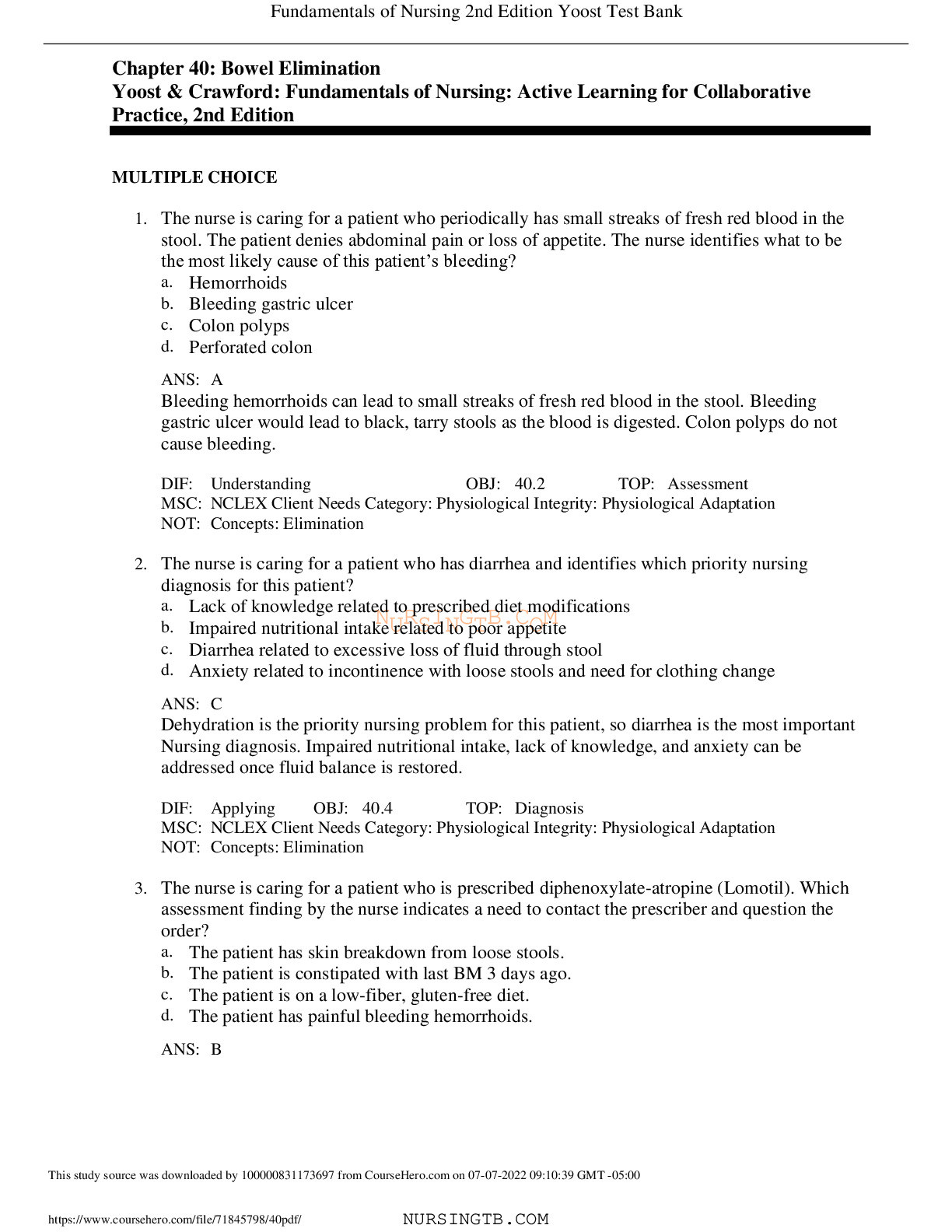All study resources > Chapter 40: Bowel Elimination Yoost & Crawford: Fundamentals of Nursing: Active Learning for Collaborative Practice, 2nd Edition (Nursing)
Chapter 40: Bowel Elimination Yoost & Crawford: Fundamentals of Nursing: Active Learning for Collaborative Practice, 2nd Edition
1. The nurse is caring for a patient who periodically has small streaks of fresh red blood in the
stool. The patient denies abdominal pain or loss of appetite. The nurse identifies what to be
the most likely cause of this patient’s bleeding?
a. Hemorrhoids
b. Bleeding gastric ulcer
c. Colon polyps
d. Perforated colon
2. The nurse is caring for a patient who has diarrhea and identifies
...[Show More]
1. The nurse is caring for a patient who periodically has small streaks of fresh red blood in the
stool. The patient denies abdominal pain or loss of appetite. The nurse identifies what to be
the most likely cause of this patient’s bleeding?
a. Hemorrhoids
b. Bleeding gastric ulcer
c. Colon polyps
d. Perforated colon
2. The nurse is caring for a patient who has diarrhea and identifies which priority nursing
diagnosis for this patient?
a. Lack of knowledge related to prescribed diet modifications
b. Impaired nutritional intake related to poor appetite
c. Diarrhea related to excessive loss of fluid through stool
d. Anxiety related to incontinence with loose stools and need for clothing change
3. The nurse is caring for a patient who is prescribed diphenoxylate-atropine (Lomotil). Which
assessment finding by the nurse indicates a need to contact the prescriber and question the
order?
a. The patient has skin breakdown from loose stools.
b. The patient is constipated with last BM 3 days ago.
c. The patient is on a low-fiber, gluten-free diet.
d. The patient has painful bleeding hemorrhoids.
4. The nurse is caring for an immobile patient who has abdominal pain and frequent small, liquid
stools. The patient vomited his breakfast and is still nauseated. Which action by the nurse is
the highest priority?
a. Provide oral care after each episode of emesis.
b. Apply a skin barrier to the patient’s perineal area.
c. Check the patient for a fecal impaction.
d. Administer antiemetic medication with a sip of water.
5. The nurse is caring for a patient who is recovering from bowel surgery. Which assessment
finding best indicates that the bowel is starting to resume function and the patient will be able
to resume oral intake soon?
a. The patient has bowel sounds x 4 quadrants and is passing gas.
b. The patient has no nausea, and abdominal pain is minimal.
c. The patient feels hungry for chicken soup and hot tea.
d. The patient’s nasogastric tube was discontinued the previous day.
6. The nurse is caring for a patient who has an ileostomy. Which Nursing diagnosis has the
highest priority for the patient?
a. Impaired skin integrity r/t localized skin irritation from liquid stool
b. Social isolation r/t potential leakage of stool from ostomy appliance
c. Lack of knowledge r/t care and maintenance of ostomy appliance
d. Disturbed body image r/t presence of stoma and altered elimination
[Show Less]
